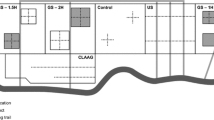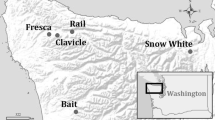Abstract
Two long-term experiments followed development of planted stock of various sizes, origins, and species. In one experiment, multiyear comparisons of container, 2-0 bareroot, and 3-year-old Douglas-fir transplants showed strong positive relationship between initial height and long-term (10–14 years) growth under a range of site conditions with high probability of brush development. In the other experiment, Douglas-fir, western hemlock, and Sitka spruce were planted in salmonberry disturbed by logging 0 and 4 years previously. Half the seedlings were released with glyphosate 6 months after planting. Hemlock and Douglas-fir bare-roots all grew well if planted in a fresh burn, despite rapid regrowth of salmonberry, but virtually all seedlings less than 60 cm tall except Sitka spruce were killed by 4-year-old salmonberry if not released. Release improved growth of seedlings in the fresh burn by 6%, gaining an average of about 0.6 year toward reaching a height of 6 m. Release improved growth of survivors in 4-year-old salmonberry by 51% in height, 72% in diameter, and 325% in volume at age 12. Sitka spruce grew well until damaged by insects. Hemlock growth was equal to or greater than that of Douglas-fir of comparable initial height. In all comparisons, the probability of being overtopped by brush decreased with increasing initial stock height, and the effect of suppression on growth was also inversely related to initial height. Field planting operations may require special logistic measures for the largest stock types.
Similar content being viewed by others
References
Allen, H. H. 1969. The interrelationships of salmonberry and Douglas-fir in cutover areas. Master's thesis. College of Forestry, Oregon State Univ., Corvallis. 56 p.
Arnott, J. J. and Burdett, A. N. 1988. Early growth of planted western hemlock in relation to stock type and controlled release fertilizer application. Can. J. Forest Res. 18: 710–717.
Autry, L. L. 1972. The residual effects of nursery fertilization and seedbed density levels on the growth of 12-, 14-, and 16-year-old loblolly pine stands. M.S. thesis. Mississippi State University, Mississippi State. 59 p.
Barnett, J. P. 1984. Relating seedling physiology to survival and growth in container-grown southern pine, Ch. 8, pp. 157–176. In: Duryea, M. L. and Brown, C. N. (Eds) Seedling Physiology and Reforestation Success. Martinus Nijhoff/Dr. W. Junk, The Hague.
Cole, E. C. and Newton, M. 1987. Fifth-year responses of Douglas-fir to crowding and nonconiferous competition. Can. J. Forest Res. 17: 181–186.
Edgren, J. W. 1977. Field survival and growth of Douglas-fir by age and size of nursery stock. USDA Forest Service Res. Paper PNW-217.6 p.
Gourley, M., Vomocil, M. and Newton, M. 1990. Forest weeding to reduce the effect of deer browsing on Douglas-fir. For. Ecol. Manag. 36: 177–185.
Hahn, P. F. and Smith, A. J. 1983. Douglas-fir planting stock performance comparison after the third growing season. Tree Plant. Notes 34(1): 33–39.
Hartwell, H. D. 1973. A comparison of large and small Douglas-fir nursery stock out-planted in potential wildlife damage areas. State of Washington Dept. of Natural Resources, Olympia. DNR Note 6. 5 p.
Helgerson, O. T. 1990. Response of underplanted Douglas-fir to herbicide injection of sclerophyll hardwoods in southwest Oregon. West. J. Appl. Forestry 5(3): 86–89.
Helgerson, O. T., Tesch, S. D., Hobbs, S. D. and McNabb, D. H. 1989. Survival and growth of ponderosa pine and Douglas-fir stocktypes on a dry low-elevation site in southwest Oregon. West. J. Appl. Forestry 4: 124–128.
Hobbs, S. D., Crawford, M. S. and Yelczny, B. A. 1989. Early development of three Douglas-fir stock types on a droughty skeletal soil. West. J. Appl. Forestry 4: 21–24.
Howard, K. M. 1979. The influence of seral Coast Range vegetation on the growth habit of juvenile Douglas-fir. M. S. thesis. Oregon State Univ., Corvallis. 208 p.
Howard, K. M. and Newton, M. 1984. Overtopping by successional Coast Range vegetation slows Douglas-fir seedlings. J. Forestry 82: 178–180.
Iverson, R. D. 1976. The efficacy of various coniferous stock types planted on brushy sites in the Oregon Coast Range. M.S. thesis. Oregon State Univ., Corvallis. 112 p.
Iverson, R. D. and Newton, M. 1980. Large Douglas-fir seedlings perform best on Oregon coastal sites. International Paper Co., Western Forest Research Center, Lebanon, OR. Res. Note 55. 9 p.
McArdle, R. D., Meyer, W. H. and Bruce, D. 1949. The yield of Douglas-fir in the Pacific Northwest. USDA Forest Serv., Washington, D.C. Bull. 201. 74 p.
Newton, M. 1978. Test of western hemlock wildlings in brushfield reclamation. Forest Res. Lab., Oregon State Univ., Corvallis. Res. Pap. 39. 22 p.
Newton, M. and Black, H. C. 1965. Large planting stock of Douglas-fir helps evade damage by animals and sprouting brush on favorable sites, pp. 46–47. In: West. Weed Control Conf., Albuquerque, New Mexico. Res. Progress Rep.
Newton, M. and White, D. E. 1985. Effect of salmonberry on growth of planted conifers. Proc. West. Soc. Weed Sci. 36: 59–65.
Newton, M., El Hassan, B. A. and Zavitkovski, J. 1968. The role of red alder in western Oregon forest succession. pp. 73–84. In: Trappe, J. M. (Ed) Biology of Alder. Northwest Scientific Association and USDA Forest Service, Pacific Northwest Forest and Range Exp. Stn., Portland.
Overton, W. S. and Ching, K. K. 1978. Analysis of differences in height growth among populations in a nursery selection study of Douglas-fir. For. Sci. 24: 497–509.
Petersen, T. D., Newton, M. and Zedaker, S. M. 1988. Influence ofCeanothus velutinus and associated forbs on the water stress and stemwood production of Douglas-fir. Forest Sci. 34: 333–343.
Rose, R. R., Carlson, W. C. and Morgan, P. 1990. The target seedling concept. In: Rose, R., Campbell, S. J. and Landis, T. D. (Eds) Target seedling symposium; Proceedings, combined meeting of the western forestry associations; August 13–17, 1990; Roseburg, OR. Rocky Mtn. For. and Range Exp. Stn., USDA For. Serv. Gen. Tech. Rep. RM-200. Ft. Collins, CO, pp. 1–8.
Smith, J. H. G. and Allen, G. S. 1962. Improvement of Douglas-fir planting stock. Faculty of Forestry, Univ. of British Columbia, Vancouver. Res. Pap. 55. 16 p.
Smith, J. H. G. and Walters, J. 1965. Influence of seedling size on growth, survival, and cost of growing Douglas-fir. Faculty of Forestry, Univ. of British Columbia, Vancouver. Res. Note 50. 7 p.
Van Goor, C. P. 1977. Trends in forestry research and its implication on silviculture. Irish Forestry 34(2): 65–80.
Walstad, J. D., Newton, M. and BoydJr., R. J. 1987. Forest vegetation problems in the Northwest, pp. 15–53. In: Walstad, J. D. and Kochs, P. I. (Eds) Forest Vegetation Management for Conifer Production. John Wiley, New York.
Walters, J. 1961. The planting gun and bullet: a new tree planting technique. Forestry Chron. 37(2): 94–95.
Walters, J. and Kozak, A. 1965. Effects of seedling size on survival and growth with particular reference to Douglas-fir. Faculty of Forestry, Univ. of British Columbia, Vancouver. Res. Pap. 72. 26 p.
Zaerr, J. B. and Lavender, D. P. 1976. Size and survival of 2–0 Douglas-fir seedlings. Forest Res. Lab., Oregon State Univ., Corvallis. Res. Pap. 32. 6 p.
Zavitkovski, J. and Newton, M. 1968. Ecological importance of snowbrush,Ceanothus velutinus, in the Oregon Cascades agricultural ecology. Ecology 49: 1134–1146.
Zavitokovski, J., Newton, M. and El Hassan, B.A. 1969. Effects of snowbrush on growth of some conifers. J. Forestry 67: 242–246.
Author information
Authors and Affiliations
Additional information
This is Paper 2706 of the Forest Research Laboratory, Oregon State University.
Rights and permissions
About this article
Cite this article
Newton, M., Cole, E.C. & White, D.E. Tall planting stock for enhanced growth and domination of brush in the Douglas-fir region. New Forest 7, 107–121 (1993). https://doi.org/10.1007/BF00034194
Received:
Accepted:
Issue Date:
DOI: https://doi.org/10.1007/BF00034194




